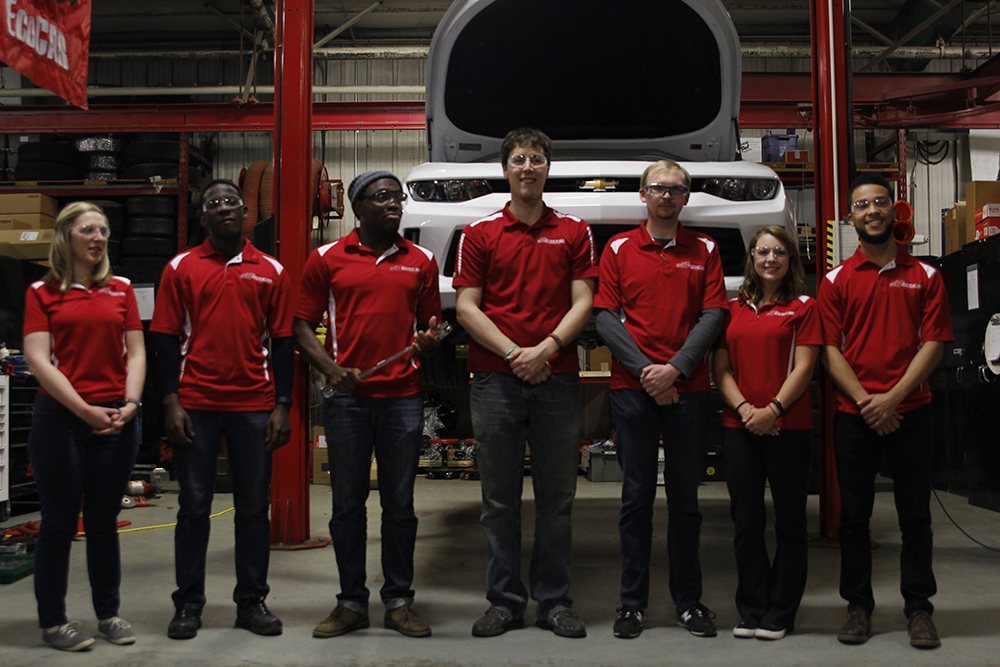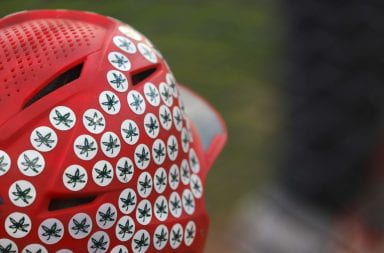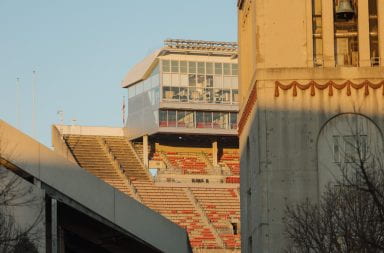
The EcoCAR team stands in front of a modified 2016 Chevrolet Camaro. Credit: Jim Xu / For The Lantern
Two Ohio State sisters are reinventing the wheel with a modified 2016 Chevrolet Camaro as a project for the national award winning OSU EcoCAR team, which continues to pave the road for advanced hybrid vehicles.
M.J. Yatsko, the EcoCAR engineering-team leader and a graduate student in mechanical engineering, joined the EcoCAR team in her first year at OSU. Now her younger sister, Katie Yatsko, a first-year in pre-mechanical engineering, is working alongside her to re-engineer a Chevy Camaro into a plug-in hybrid electric vehicle.
“I’ve known about EcoCAR for a long time because of my sister, and I had the opportunity as a high-school student to intern over the summer with the EcoCAR team,” Katie Yatsko said.
Their objective is to make the Camaro a hybrid vehicle while maintaining performance, MJ Yatsko said.
EcoCAR is sponsored by the U.S. Department of Energy and General Motors, and it is managed by Argonne National Laboratory. M.J. Yatsko said that this partnership is really beneficial for the teams.
“They donated the (Camaro) to us, and each team is given a mentor who is an engineer at GM,” she said. “A lot of times we get the question, ‘Why is GM involved?’ It is really because of the students. A lot of the students are involved in this program so they can go work for one of the companies involved.”
The EcoCAR experience provided Katie Yatsko with a career opportunity. She accepted an internship with Cummins, a diesel company based in Columbus, Indiana. She said that the reason it showed interest in her was her involvement with EcoCar.
“I can’t even begin to think of what opportunities I’m going to get because of EcoCAR,” she said. “You get guidance not only in the mechanical aspects, but other students who have gone through engineering can help me with what classes to take and what I need to be doing other than EcoCAR to be successful while I’m here.”
Nick Tomczak, a third-year in industrial and systems engineering, also accepted an internship with Amazon as an operations leader with the help of his EcoCAR experience.
“As a leader at EcoCAR, it pushed me to stand out in a unique program,” Tomczak said.
M.J. Yatsko said the ultimate goal of EcoCAR is to give students “a hands-on learning experience and to encourage them to find out what areas are most interesting to them.”
“It is not limited, by any means, to engineering. We’ve had communications people, business people. There is a finance major, and an information systems major,” Tomczak said.
The current OSU team consists of roughly 40 members ranging from first-year students to graduate students.
“People think they don’t have enough experience to join the team, but the awesome thing is that everybody here started from not knowing anything (about the team), and (the instructional members) are really happy to teach you and make sure you are up to speed,” Katie Yatsko said.
M.J. Yatsko said she remembered her first project, in which she helped design a mount for an air box in a vehicle.
“That little project is important,” she said. “I try to help (members) understand that every project on the car counts.”
The OSU team won first place in year one of the Camaro competition, beating out Virginia Tech and the University of Waterloo, in Canada, in 2015 after presenting its Camaro design to the judges. The team also took first place in 2014 with its re-engineered Hybrid Chevrolet Malibu, receiving a total of $32,000 in award money, according to the EcoCAR website.
Currently the team is in the second year of a four-year competition, working with the Camaro.
Its workshop, the Center for Automotive Research, is just a mile away from campus. It is the home to the 2016 Camaro and other OSU automotive projects, such as the Buckeye Bullet, an alternative-fuel race car. Inside, members spend six to eight hours a week between two meetings, Katie Yatsko said.
“Engineering is pretty hard and theoretical, so being able to connect it back to something you are passionate about is pretty cool. We have team leaders who are willing to take the time to teach the students,” M.J. Yatsko said. “If their goal is to work in the automotive industry, there really is no better way to work on a project like this.”


